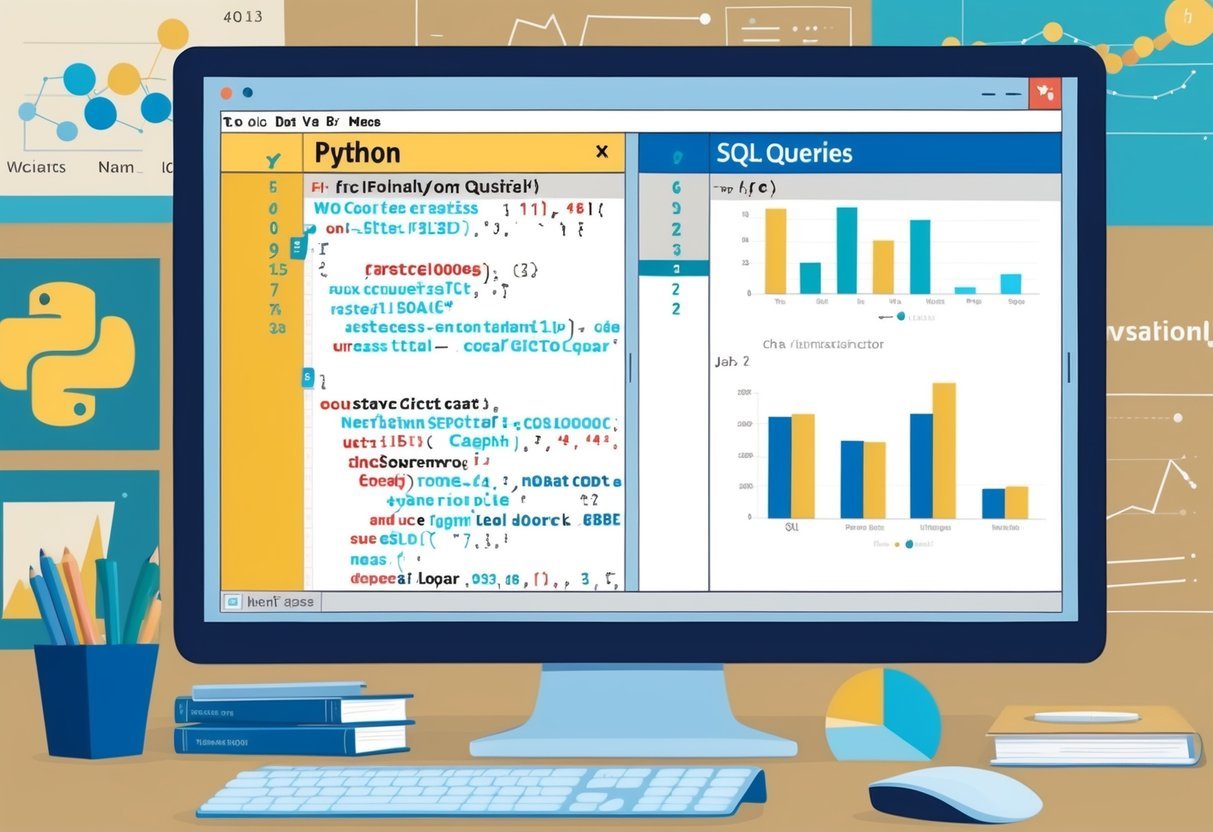Understanding T-SQL for Backup and Restore
T-SQL, or Transact-SQL, is essential for managing data in SQL Server. It enables users to execute database backups and restores with precision. Through T-SQL commands, one can back up databases or restore them without relying solely on graphical interfaces like SQL Server Management Studio (SSMS).
Common Commands
-
Backup a Database:
BACKUP DATABASE YourDatabase TO DISK = 'C:\Backup\YourDatabase.bak'This command saves a copy of the database to a specified location.
-
Restore a Database:
RESTORE DATABASE YourDatabase FROM DISK = 'C:\Backup\YourDatabase.bak'It brings back the database from the backup file.
Learning T-SQL involves mastering commands like BACKUP and RESTORE for efficient database management. T-SQL scripts provide flexibility, allowing automation and scheduling of backup tasks.
Expertise in these scripts can prevent data loss and minimize downtime. With the right skills, users can perform complex tasks like moving database files or configuring log backups as discussed in Database Backup Strategies.
Benefits of T-SQL
- Automation: Automate regular backups to ensure data safety.
- Customization: Tailor backup strategies to meet specific needs and constraints.
- Flexibility: Perform operations remotely or integrate with other applications.
Understanding T-SQL for backup and restore operations empowers users to protect data efficiently. Whether working in large enterprises or small setups, these skills are crucial for effective database management.
Exploring SQL Server Backup Types
Exploring SQL Server backup types is crucial for effective data management and recovery. Each type offers unique features that suit different needs and situations. Knowing how to use these backups helps maintain database integrity and availability.
Full Database Backups
Full database backups are the most comprehensive, capturing the entire database including all objects and data. They provide a complete snapshot at a specific point in time, making them essential for restoring the database to its exact state.
Full backups are easy to manage and are the foundation for other backup types, like differential backups. However, they can be time-consuming and require significant storage space, especially for large databases.
These backups are typically run during off-peak times to minimize impact on server performance. Scheduling weekly full backups is common practice in many organizations.
Differential Backups
Differential backups capture only the changes since the last full backup. This means they grow larger with every transaction until the next full backup is taken.
Using differential backups reduces the time and storage needed compared to full backups. Restoring from a differential backup involves the last full backup and the most recent differential backup.
This simplicity makes differentials a popular choice for organizations looking to balance efficiency and recovery speed. They are typically scheduled daily or more frequently depending on data change rates.
Transaction Log Backups
Transaction log backups focus on capturing changes recorded in the database’s transaction log. These backups allow for point-in-time recovery, which is crucial for databases with high transaction volumes.
They help reduce data loss by recording every change made to the database since the last log backup. Managing transaction log backups frequently, such as every 10 to 15 minutes, can significantly cut potential data loss.
However, they require the database to be in full or bulk-logged recovery mode. Restoring involves using the last full backup followed by the chain of transaction logs.
Copy-Only Backups
Copy-only backups do not alter the database’s backup sequence. This means they can be taken without affecting scheduled differential or log backups.
These are ideal for special scenarios like data migrations or testing environments where a backup is needed but should not influence other backup strategies. Though not a replacement for regular full backups, they offer flexibility and control over backup processes.
It’s crucial to use them wisely to ensure they serve their intended purpose without complicating the restore process.
Partial Backups
Partial backups focus on backing up certain parts of the database, specifically the primary filegroup and any read-write secondary filegroups. They are particularly useful for large databases where backing up the entire set isn’t feasible regularly.
This method allows faster backups by omitting parts of the database that are not critical or frequently changed. This type of backup is suitable for databases using read-only filegroups that rarely change. Businesses often use them to save time and storage costs while ensuring that important data is protected.
Snapshot Backups
Snapshot backups capture the database at a precise moment in time using a database snapshot. They are stored in a sparse file that grows until it’s deleted.
Snapshots are primarily used for reporting or testing purposes as they offer a quick view of the database without making a full copy. While snapshot backups provide speed and efficiency, they do not replace other backup types for restoration purposes.
They lack the robustness of a full or differential backup and are generally not used for recovery scenarios. Instead, they offer a rapid means to check data at a specific state.
Setting Up the Backup Environment
Creating a reliable backup environment in SQL Server involves making careful choices about recovery models and selecting suitable backup devices and media. These elements ensure data protection and efficient restoration.
Choosing the Correct Recovery Model
Selecting the right Recovery Model is crucial for effective database management in SQL Server. There are three primary models: Simple, Full, and Bulk-Logged. Each model defines how transactions are logged, influencing recovery options and storage requirements.
-
Simple Recovery: This model is ideal for environments where losing some transactional data is acceptable, as it doesn’t log every transaction detail. It simplifies management but limits recovery to the last full backup.
-
Full Recovery: Suitable for critical databases where data loss is unacceptable. It logs all transactions, enabling point-in-time recovery. However, it requires regular log backups to manage file size and ensure recovery options.
-
Bulk-Logged Recovery: Used for bulk operations to minimize log space usage while allowing for some data recovery options. It’s a middle ground between the other two models, providing both efficiency and some security against data loss.
Utilizing Backup Devices and Media
The choice of Backup Devices and Media impacts both the efficiency and reliability of the backup process. SQL Server allows backups to be stored on various media, such as:
-
Tape Drives: Traditional but less common now, used for long-term storage due to cost-efficiency and capacity.
-
Disk Drives: Offer faster access and restoration times compared to tape. They can be local or network-attached.
-
Cloud Storage: An increasingly popular option for backups, offering scalability and accessibility.
Backup Devices can be configured in SQL Server for automated processes. Using dedicated devices ensures reliable performance and reduces the risk of data corruption or loss.
Regular testing and validation of backups on chosen media are essential to verify the integrity and usability of backups.
Implementing Backup Strategies
Implementing effective backup strategies involves planning a backup schedule, managing backup files, and automating processes. Each aspect ensures data is protected and can be recovered efficiently.
Creating a Backup Schedule
A well-defined backup schedule is crucial for safeguarding data. It determines when and how often to back up databases.
Daily full backups are common, but they might not fit every scenario. Some may prefer weekly full backups with daily differential backups to save time and storage.
Consider the database size and change rate when setting up the schedule. More frequent backups might be necessary for databases with high transaction volumes. Including periods of low activity can minimize disruption.
Managing Backup Files
Managing backup files is vital to prevent data loss and optimize storage. Regularly check the integrity of backup files to ensure they can be used for restoration.
Use compression to reduce file size, and store backups in multiple locations to protect against hardware failures.
Organize files systematically, using clear naming conventions and timestamps. This helps quickly locate specific backups when needed.
Archive older backups periodically to free up space, but ensure they remain available if needed for compliance or audits.
Automating Backup Processes
Automation simplifies backup tasks and reduces the risk of human error. Many tools can automate the entire process, from creating backups to storing and verifying them.
Schedule automation tools to run during off-peak hours to minimize impact on database performance.
Set up alerts for failed backups to ensure prompt corrective action. Regularly update and test automated processes, as software or system updates might affect them.
By automating, organizations can ensure consistent backups without constant manual oversight.
Executing Backups Using SSMS and T-SQL
Backups are crucial to safeguard database information. This section covers executing backups through both the Graphical User Interface in SQL Server Management Studio and the Transact-SQL command method. Each provides a way to save data securely, with options suited for different users.
Graphical User Interface (GUI) Method
With SQL Server Management Studio (SSMS), backups can be made using the GUI. Begin by opening SSMS and connecting to the desired database.
Locate the database in the Object Explorer pane. Right-click on the database name and choose Tasks > Back Up…
In the Back Up Database window, select the backup type: Full, Differential, or Transaction Log.
Choose a destination file path by clicking Add… to save the backup. Check all settings, then click OK to start the backup process.
This method is user-friendly for those who prefer visual guidance when making database backups.
Transact-SQL Command Method
Transact-SQL (T-SQL) offers a script-based alternative for backups. Open a new query window in SSMS.
Use the BACKUP DATABASE command to specify the database and backup location.
Example command:
BACKUP DATABASE [YourDatabaseName]
TO DISK = 'C:\Backups\YourDatabase.bak'
WITH FORMAT;
Replace [YourDatabaseName] with the actual database name. This approach is efficient for users who manage multiple backups or prefer automation.
T-SQL scripts can be saved and run regularly using SQL Server Agent for scheduled tasks, making it a robust option for database administrators.
Managing Backup Security and Integrity
Ensuring the security and integrity of database backups is crucial for data protection and recovery. Proper encryption methods and verification processes play a vital role in safeguarding sensitive information and maintaining data accuracy.
Implementing Backup Encryption
Backup encryption is fundamental to securing data in SQL Server. It protects sensitive information from unauthorized access by encoding the data.
SQL Server provides options like Transparent Data Encryption (TDE) and Backup Encryption using T-SQL. TDE encrypts the backup at the database level, while backup encryption can be specified during the backup process itself.
When enabling encryption, choose a strong algorithm like AES-256. This provides robust protection against breaches.
Additionally, managing encryption keys and certificates properly is vital. They should be stored securely, with regular updates to minimize risk.
By using these methods, organizations can ensure that their data remains confidential and protected even when backups are offsite.
Verifying Backups with Checksum
Verifying backups with checksum is a critical step to ensure data integrity. The checksum process involves creating a digital signature for data blocks, allowing for verification of data accuracy.
When performing a backup, using the WITH CHECKSUM option helps detect any corruption in the backup file.
Checksum verification can also be done during the restore process. This ensures that any issues are identified before the data is used.
Implementing regular consistency checks is also important. DBCC CHECKDB commands can be used to perform checks on the database, identifying potential corruption.
By integrating these practices, organizations can proactively maintain the integrity of their backups. This reduces risks and ensures reliable data recovery when needed.
Operational Recovery Techniques
Operational recovery techniques in SQL Server revolve around performing effective restore operations and utilizing high availability features like Always On Availability Groups. These strategies ensure minimal downtime and data loss, enhancing the resilience and efficiency of database management systems.
Performing Restore Operations
Performing a restore operation is a critical task in operational recovery. It involves the process of reconstructing data from backups to bring a database back to its last known good state.
Database administrators use various methods, including full, differential, and transaction log backups, each serving specific recovery purposes.
Using T-SQL scripts, administrators can automate the restore process, ensuring consistency and accuracy.
The RESTORE DATABASE command allows for precise control over recovery options, such as specifying a recovery point in time. This flexibility is vital for maintaining data integrity and minimizing downtime.
Another consideration is the recovery model of the database, which determines how transaction logs are maintained. Choosing the appropriate model influences the ease and speed of the restoration process, addressing specific business needs.
Working with Always On Availability Groups
Always On Availability Groups enhance database availability and flexibility. This feature involves setting up groups of related databases to failover together, providing a high level of redundancy and minimal downtime during failures.
To implement Always On, you must configure the availability groups with appropriate modes: synchronous for zero data loss, and asynchronous for high performance. These options balance the trade-off between speed and data safety.
Joining a database to an availability group can also allow for offloading read operations to secondary replicas, improving performance under heavy workloads. This setup requires SQL Server Management Studio (SSMS) or T-SQL commands, ensuring precise configuration and control over database operations.
Advanced Backup Features
Advanced backup features in SQL Server focus on optimizing storage and enhancing efficiency. Techniques such as compression and using cloud services like Microsoft Azure for backup can greatly improve backup processes. These methods offer benefits such as reduced storage space and increased flexibility.
Compression Options
Compression in SQL Server is a valuable feature that reduces the size of backup files, saving storage space and potentially improving performance. When a backup is compressed, the process lowers disk space requirements, which leads to less I/O activity.
There are two main types of compression available: row and page compression. Both aim to minimize storage, but they operate differently.
Row compression reduces the amount of storage used by changing the format of the data storage. Page compression takes this further by consolidating duplicate dictionary entries within pages.
These methods can be managed through T-SQL commands or SSMS, making them accessible for database administrators looking to optimize their backup strategy. Detailed information on these features can be found in SQL Server Backup and Restore.
Backup to Microsoft Azure Blob Storage
Migrating backups to cloud solutions such as Microsoft Azure Blob Storage provides flexible and scalable storage options. This method allows for off-site storage, enhancing data security against local data center failures.
Azure Blob Storage offers a cost-effective and reliable solution for storing large backup files securely.
The integration with SQL Server is straightforward, involving setting up the storage account and configuring credentials. Once set, backups can be directed to the cloud using the same tools and commands used for local storage.
This approach also simplifies data recovery processes, as backups can be accessed and restored remotely. For in-depth guidance on setting this up, reading Beginning Backup and Restore for SQL Server is recommended.
Troubleshooting and Monitoring Backups
Efficient handling of backups is crucial for maintaining data integrity in SQL Server databases. It is essential to address backup failures promptly and monitor jobs regularly to prevent data loss and manage disk space effectively.
Handling Backup Failures and Data Loss
Backup failures can lead to significant data loss, making it vital to detect and resolve issues quickly. Common causes of failures include media failure, incorrect configurations, and insufficient permissions.
Regularly verifying backups for integrity can prevent potential problems.
In case of a failure, checking the SQL Server error log for detailed error messages is beneficial. It helps in pinpointing causes, such as faulty hardware or incorrect backup paths.
Having a robust recovery plan aids in minimizing downtime and restoring data efficiently. The use of tools like SQL Server Advanced Troubleshooting and Performance Tuning can help address these challenges.
Monitoring Backup Jobs and Disk Space
Monitoring backup jobs ensures that they execute as scheduled and complete successfully. Setting up alerts for job failures allows for timely response to issues.
Using SQL Server Management Studio (SSMS) or T-SQL scripts can help monitor the backup job status effectively.
Disk space management is also critical. As databases grow, regular checks using the sp_spaceused stored procedure can track the space occupied by database objects and files.
Ensuring adequate disk space prevents interruptions in backup processes. Implementing automated scripts to manage space can enhance the efficiency and reliability of backup operations, as emphasized in materials like High Availability and Disaster Recovery.
Database Restore Strategies and Techniques
Managing database restores ensures data integrity and minimizes downtime. Key considerations include choosing the right restore options and handling multiple files and file groups.
Choosing Appropriate Restore Options
Selecting the right restore options is crucial for successful database recovery. In SQL Server, one can choose between full, differential, and transaction log restores. Each type serves a distinct purpose.
A full restore retrieves the entire database to a specific point in time, ideal for complete recovery scenarios.
Differential restores, on the other hand, capture changes since the last full backup. These are useful when a faster restore is desired, as they require less time and resources.
Transaction logs allow for point-in-time recovery, providing flexibility in restoring specific operations.
Selecting the correct sequence of these restores is vital. Typically, a full restore is followed by the latest differential backup and then the necessary transaction logs. This ensures data consistency and minimizes data loss.
Employing the right combination of these options aligns with organizational needs and recovery objectives.
Restoring Multiple Files and File Groups
Restoring multiple files or file groups is an effective strategy in environments with large databases. SQL Server facilitates restoring individual files without affecting the entire database, saving time and resources.
This approach is especially beneficial for large systems where downtime needs to be minimized.
File-based restores allow specific areas of the database to be brought online rapidly. For instance, if a non-critical file group needs restoration, unaffected parts of the database remain accessible, maintaining partial functionality.
This level of granularity in restore operations enhances flexibility in backup strategies.
When initiating such restores, it’s important to ensure the backup includes all necessary file-specific backups and logs. Using scripts or commands specifically tailored to the targeted file groups ensures efficiency and accuracy during the restore process. This strategic approach supports effective database management and operational continuity.
Working with Azure SQL in Backup and Restore
When using Azure SQL for database backups and restore, it’s crucial to understand the specific solutions available for the Azure SQL Database and the Azure SQL Managed Instance. Each offers distinct tools and approaches to ensure data protection and recovery.
Backup Solutions for Azure SQL Database
Azure SQL Database provides automated backups that enable point-in-time restore for up to 35 days. Users can benefit from full, differential, and transaction log backups, which are stored in Azure Blob Storage.
For additional protection, geo-redundant backups can also be configured, allowing data restoration in another region if necessary. This feature is crucial for disaster recovery and maintaining high availability.
Admins use the portal, PowerShell, or Azure CLI to manage these backups. It is essential for administrators to configure these settings to suit their recovery objectives while considering cost and storage capacity.
Backup and Restore for Azure SQL Managed Instance
Azure SQL Managed Instance offers full support for native SQL Server backup and restore. This capability provides easier migration for on-premises SQL Server users.
Full, differential, and transaction log backups are supported and stored in Azure Blob Storage.
Admins can automate these backups by using Azure Automation or SQL Server Agent jobs. Recovery is made simple, with the ability to restore data to any point in time within the retention period.
For businesses needing to maintain SLA and compliance, understanding how to leverage these tools is critical. Attention to backup frequency and retention policies can help meet data recovery goals efficiently.
Frequently Asked Questions
This section provides answers to common questions about SQL Server database backup and restore using T-SQL commands. It covers how to perform backups, transfer them between servers, set up automation, and use specific scripts.
How do you perform a backup and restore of a database in SQL Server using T-SQL commands?
To back up a SQL Server database, use the BACKUP DATABASE T-SQL command. This command specifies the database name and the backup location. To restore, use the RESTORE DATABASE command with details of the backup file path. Both commands involve specifying the database and file paths.
What steps are involved in transferring a SQL Server database backup from one server to another?
First, perform a backup using BACKUP DATABASE. Next, copy the backup file to the destination server.
Finally, execute the RESTORE DATABASE command on the new server. Make sure the destination server has enough space and permissions to complete the restoration.
What are the steps for setting up automatic backups for SQL Server databases?
Use SQL Server Agent to schedule backups. Create a new job in SQL Server Management Studio (SSMS), add a backup step using T-SQL commands, and set a schedule.
This ensures regular backups occur without manual intervention.
Can you provide a script for restoring a SQL Server database using T-SQL?
A basic restore script is:
RESTORE DATABASE [YourDatabase]
FROM DISK = 'C:\Backups\YourBackup.bak'
WITH RECOVERY;
Replace [YourDatabase] with the actual database name and update the backup file path.
What are the different types of backups available in SQL Server, and when should each be used?
SQL Server offers full, differential, and transaction log backups.
Full backups capture the entire database and are done regularly. Differential backups save changes since the last full backup.
Transaction log backups focus on log entries and are used to recover more recent transactions.
What is the distinction between the backup and restore processes in SQL Server?
Backing up involves creating a copy of the database’s data and transaction logs to protect against data loss. Restoring means retrieving this data to recreate the database at a prior point.
The backup process saves data, whereas restore applies it back to the server.


































